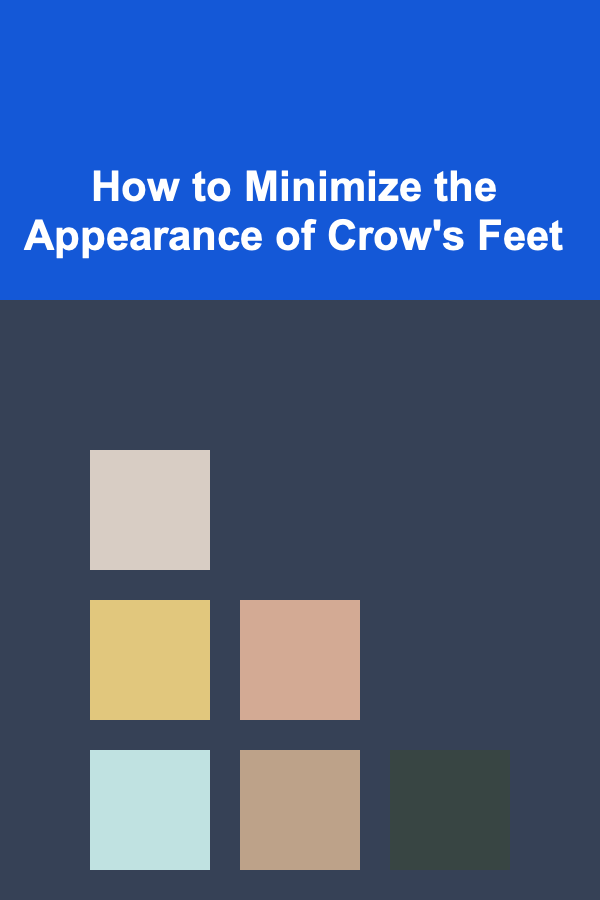
How to Minimize the Appearance of Crow's Feet
ebook include PDF & Audio bundle (Micro Guide)
$12.99$5.99
Limited Time Offer! Order within the next:

Crow's feet, often referred to as laugh lines or eye wrinkles, are a natural part of the aging process. They appear as fine lines and wrinkles at the outer corners of the eyes and are typically the result of years of facial expressions such as smiling, squinting, and laughing. As we age, the skin loses collagen, elastin, and moisture, leading to the formation of wrinkles. While crow's feet are inevitable, there are several ways to minimize their appearance and maintain youthful-looking skin. This article will explore the science behind crow's feet, causes, and how to prevent or reduce them through lifestyle changes, skincare routines, and cosmetic treatments.
Understanding Crow's Feet
What Are Crow's Feet?
Crow's feet are the fine lines or wrinkles that form at the outer corners of the eyes. They are one of the first signs of aging and can develop in both men and women, typically starting in their late 20s or early 30s. These wrinkles are often associated with facial expressions, such as laughing, smiling, or squinting. Over time, repetitive muscle movements in the area around the eyes can cause these wrinkles to become more pronounced.
Causes of Crow's Feet
Several factors contribute to the formation of crow's feet, including both intrinsic and extrinsic aging processes.
Intrinsic Aging
Intrinsic aging, also known as chronological aging, refers to the natural aging process that occurs as we get older. As we age, our skin becomes thinner, less elastic, and loses its ability to retain moisture. This makes the skin more prone to wrinkles, including those around the eyes. The production of collagen and elastin, proteins responsible for maintaining skin structure and elasticity, also decreases with age, leading to the gradual formation of wrinkles.
Extrinsic Aging
Extrinsic aging is caused by external factors such as sun exposure, environmental pollution, smoking, and poor lifestyle habits. UV radiation from the sun is one of the primary culprits behind the formation of wrinkles, as it accelerates the breakdown of collagen and elastin fibers in the skin. In addition, pollutants and toxins can cause oxidative stress, further weakening the skin's ability to maintain its structure.
Risk Factors
While crow's feet are a natural part of aging, certain factors can increase their appearance or accelerate their development. These risk factors include:
- Sun Exposure: Prolonged exposure to UV rays without protection is one of the leading causes of premature skin aging and the development of wrinkles around the eyes.
- Smoking: Smoking contributes to the breakdown of collagen and elastin in the skin, which leads to premature aging and the formation of wrinkles.
- Genetics: Your genes play a significant role in how your skin ages. If your parents developed crow's feet early, you may be more prone to them.
- Facial Expressions: Repeated facial expressions, such as squinting or smiling, can contribute to the development of crow's feet over time.
Prevention of Crow's Feet
1. Protect Your Skin from the Sun
The most important step in preventing crow's feet is protecting your skin from sun damage. UV rays can accelerate the breakdown of collagen and elastin, leading to premature aging and wrinkles. Here are some effective ways to protect your skin:
- Wear Sunscreen Daily: Use a broad-spectrum sunscreen with an SPF of 30 or higher every day, even on cloudy days. Apply sunscreen to the delicate skin around your eyes to protect it from UV damage.
- Wear Sunglasses: Sunglasses that block UVA and UVB rays will protect your eyes and the skin around them from harmful sun exposure. Opt for sunglasses with wide lenses that cover the area around your eyes.
- Seek Shade: Avoid prolonged sun exposure, especially during peak hours (10 AM to 4 PM), when the sun's rays are the strongest. Whenever possible, seek shade or wear a wide-brimmed hat to protect your face.
2. Stay Hydrated and Moisturize
Dehydrated skin can exacerbate the appearance of crow's feet and other wrinkles. Ensuring that your skin is well-hydrated is essential for maintaining its elasticity and reducing the visibility of fine lines.
- Drink Plenty of Water: Aim to drink at least 8 glasses of water per day to keep your skin hydrated and supple.
- Use Moisturizing Products: Invest in a rich, hydrating eye cream or serum designed to nourish the delicate skin around the eyes. Look for products containing ingredients like hyaluronic acid, peptides, and glycerin, which help retain moisture and keep the skin plump.
3. Avoid Smoking and Limit Alcohol Consumption
Both smoking and excessive alcohol consumption can accelerate the aging process and contribute to the formation of wrinkles. Smoking damages collagen and elastin fibers in the skin, while alcohol dehydrates the skin and causes it to lose its elasticity. Quitting smoking and reducing alcohol intake can significantly improve your skin's appearance and help minimize the appearance of crow's feet.
4. Get Enough Sleep
Adequate sleep is crucial for skin repair and regeneration. When you don't get enough sleep, your body produces more cortisol, a stress hormone that can break down collagen and elastin in the skin. Aim for 7-9 hours of sleep per night to support skin health and reduce the appearance of wrinkles.
5. Practice Facial Exercises
Facial exercises can help tone and tighten the muscles around your eyes, which may reduce the appearance of crow's feet. Here are some simple exercises to try:
- Eye Squeeze: Close your eyes tightly for 5-10 seconds and then relax. Repeat this exercise several times.
- Eye Circles: Gently place your ring fingers around the outer corners of your eyes and make small circular motions, massaging the area. This will help stimulate blood flow and improve skin elasticity.
Skincare Treatments to Minimize Crow's Feet
1. Retinoids
Retinoids are a powerful class of ingredients that can help reduce the appearance of crow's feet by stimulating collagen production and increasing skin cell turnover. Retinoids, such as retinol, tretinoin, and retinaldehyde, help reduce the visibility of fine lines and wrinkles over time.
- How to Use: Apply a retinoid cream or serum at night after cleansing. Start with a lower concentration and gradually increase as your skin becomes accustomed to it. Be sure to use sunscreen during the day, as retinoids can increase sun sensitivity.
2. Peptides
Peptides are short chains of amino acids that can help improve skin elasticity and stimulate collagen production. Peptide-based creams and serums can help firm and tighten the skin around the eyes, reducing the appearance of crow's feet.
- How to Use: Look for eye creams or serums containing peptides and apply them to the outer corners of your eyes. Use them consistently to see results.
3. Hyaluronic Acid
Hyaluronic acid is a humectant that helps draw moisture into the skin, making it an excellent ingredient for minimizing the appearance of crow's feet. By keeping the skin hydrated and plump, hyaluronic acid can reduce the visibility of fine lines and wrinkles.
- How to Use: Apply a hyaluronic acid serum or moisturizer around your eyes to keep the skin hydrated and smooth.
4. Botox and Fillers
For more immediate and dramatic results, some people turn to injectables like Botox or dermal fillers. Botox works by temporarily paralyzing the muscles that cause wrinkles, while dermal fillers restore volume to the skin and plump up fine lines and wrinkles.
- Botox: Botox injections can temporarily smooth out crow's feet by relaxing the muscles responsible for causing the wrinkles.
- Dermal Fillers: Fillers such as hyaluronic acid can restore volume to the skin, reducing the depth of crow's feet and giving the skin a smoother appearance.
Both treatments provide temporary results, and the effects usually last 3-6 months before needing a touch-up.
5. Laser Treatments
Laser treatments such as fractional CO2 lasers or erbium lasers can help stimulate collagen production and improve skin texture. These treatments work by creating controlled micro-injuries in the skin, which promotes healing and the formation of new, youthful skin cells.
- How It Works: During the procedure, the laser targets the skin around the eyes, stimulating collagen production and improving skin tone. The results can last for several months, and multiple treatments may be required for optimal results.
Conclusion
While crow's feet are a natural part of aging, there are several ways to minimize their appearance and keep your skin looking youthful. By protecting your skin from the sun, staying hydrated, practicing facial exercises, and incorporating the right skincare treatments, you can significantly reduce the visibility of crow's feet. Additionally, for more dramatic results, injectable treatments and laser therapies can provide effective solutions.
No matter which approach you choose, consistency is key. By adopting a comprehensive skincare routine and making lifestyle changes, you can enjoy smoother, younger-looking skin and feel more confident in your appearance.

How to Create a Checklist for Overcoming Procrastination
Read More
How To Pick the Perfect Satirical Comedy
Read More
How to Stage Your Home's Curb Appeal to Attract Buyers
Read More
How to Start a Family Exercise Routine at Home
Read More
The Art of CFO Leadership: Navigating Finance and Driving Business Innovation
Read More
How To Take Unique Still Life Photos
Read MoreOther Products

How to Create a Checklist for Overcoming Procrastination
Read More
How To Pick the Perfect Satirical Comedy
Read More
How to Stage Your Home's Curb Appeal to Attract Buyers
Read More
How to Start a Family Exercise Routine at Home
Read More
The Art of CFO Leadership: Navigating Finance and Driving Business Innovation
Read More